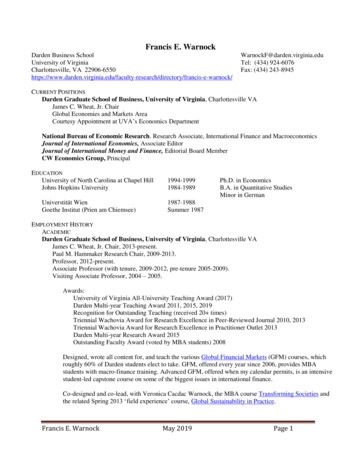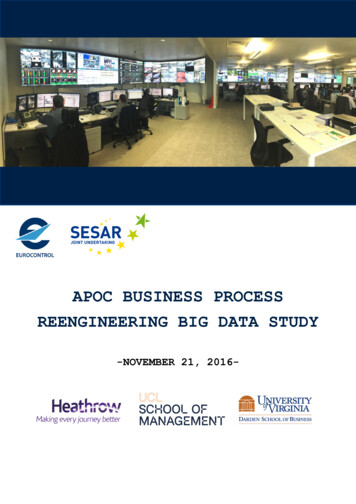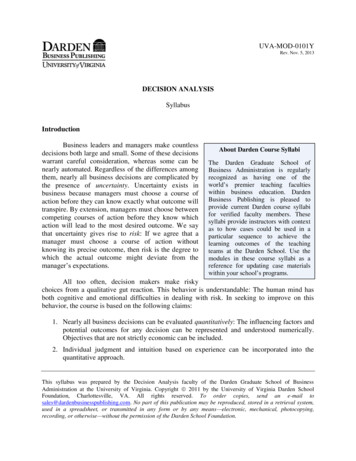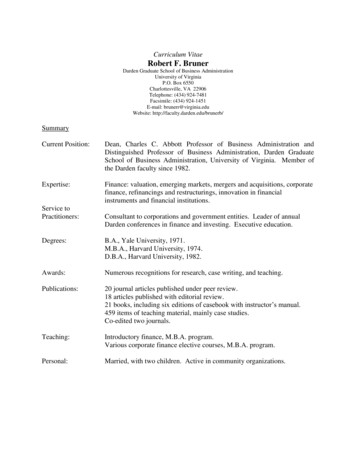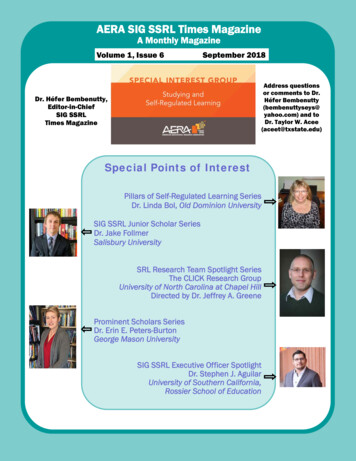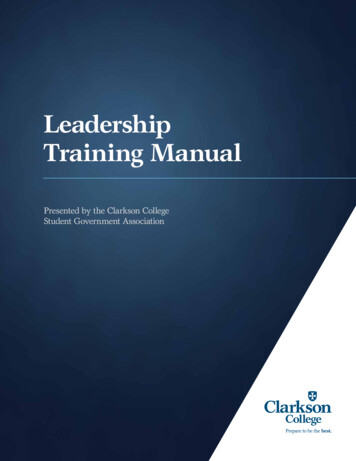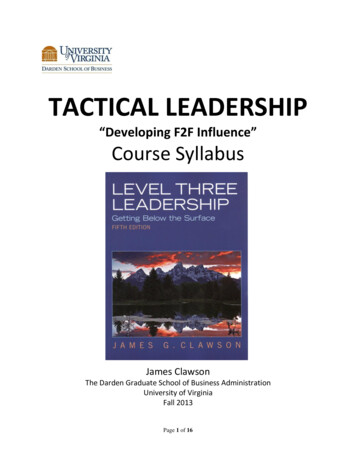
Transcription
TACTICAL LEADERSHIP“Developing F2F Influence”Course SyllabusJames ClawsonThe Darden Graduate School of Business AdministrationUniversity of VirginiaFall 2013Page 1 of 16
TACTICAL LEADERSHIPThe Darden School improves the world by developing and inspiring responsible leadersand by advancing knowledge.Darden School Mission StatementConsistent with the mission of the school, all students are required to have aleadership-learning experience of at least 1.5 credit hours while attending Darden in order tograduate.Academic Policies and Procedures ManualCOURSE OBJECTIVESThe goal of this course is to help you enhance your skills at influencing others inface-to-face and one-on-many settings. In particular, this course focuses on influencing at LevelThree or the basic value level. The course, with your engagement, will deliver to you1.2.3.4.5.Enhanced understanding about why people behave the way they do.Greater understanding about how to influence others face-to-faceA framework for organizing your personal and commercial strategic thinkingSignificant practice influencing othersIncreased insight into your own leadership style, strengths and flat spotsCOURSE ORGANIZATIONTactical Leadership is organized around a set of modules. These modules and theirrelated core questions are:IntroductionWhy do people (including you) behave the way they do?Influence ToolsWhat are your influence options?Level One ApproachInfluencing BehaviorLevel Two ApproachInfluencing ThoughtLevel Three ApproachInfluencing BeliefContagionHow does how you feel affect your performance, decisions andinfluence on others?Identifying VABEsHow does one identify or “see” others’ VABEs?ConclusionWhat do you want to be and how do you want to influence others?The meaning of these modules will become clear to you as the course unfolds. See theCourse Schedule below.Page 2 of 16
REQUIRED MATERIALS1. Level Three Leadership: Getting Below the Surface Fifth Edition (Clawson, Prentice-Hall,2010)2. Access to COURSE j/COURSES/TACTICAL LEADERSHIP/TACTICAL-LEADERSHIP.htm3. Case Packet from DEMSON RESERVE IN THE LIBRARYFor those of you who want to learn more about the issues raised in the course, you may beinterested in acquiring and reading the following. Copies are on reserve in the library.1.2.3.4.5.6.7.Punished by Rewards, Alfie KohnThe Structure of Scientific Revolutions, Thomas KuhnThe Virus of the Mind, BrodieLeadership and Organizational Culture, Ed ScheinLevel Three Leadership 5th Edition, James Clawson, Prentice-Hall, 2010The Path of Least Resistance, Robert Fritz, 1989Powered by Feel: how individuals, teams and companies excel, James Clawson & DougNewburg, World Scientific, 20098. Outliers, Malcolm Gladwell, 20099. Influence without Authority, Dave Bradford & Allan Cohen, John Wiley & Sons, NY,1991.10. Influence: The Psychology of Persuasion, Robert Cialdini, Quill, New York, 1993.11. Balancing Your Life: Executive Lessons for Work, Family and Self, James Clawson, WorldScientific: Singapore, 2009.Page 3 of 16
COURSE REQUIREMENTS and PRINCIPLES1. PREPARATION AND PARTICIPATION: (50% of your grade) With regard to participation,if you learn a lot but never share that with others what good is it? I place a high valueon honest, forthright discussion and debate about real issues. You are in class as muchfor what you contribute as for what you take away. I invite and expect you to becontributing to the discussion in every class.2. FINAL PROJECT: (50% of your grade.) See below.3. TRIAD PARTNERS: At the beginning of the course, I will ask you to form three-person“Triad Teams.” You should select two people with whom you are comfortable talkinghonestly and deeply. We will use these Triad Teams to practice various skill sets duringthe course, and to engage in-class buzz sessions.4. STUDENT LEADERSHIP: It’s hard to practice leadership waiting for someone else(instructor) to set the agenda. Consequently, there will be times when I’ll ask membersof the class to lead the discussion. This activity will help you develop your planning andleadership skills.Page 4 of 16
CLASS DEPORTMENT REQUESTSI invite/ask you to:1. Share my interest in having active, honest, deep discussions about important principlesin leading and living (help create a high energy learning bubble in the room).2. Come on time. (to protect the bubble)3. Do not come and go from class; it disrupts the discussion. (breaks the bubble)4. Come prepared having read all of the materials for the class. (creating the bubble, seeClawson Family Principle #7 on my website.)5. Be respectful of your classmates. Don’t dominate the discussions; invite your quieterpeers into the discussion. If you tend to be quiet, stretch yourself to share your viewswith your classmates to enhance their learning and understanding.6. Do not wear hats in class, please. (respect for classmates, a VABE from my mother)GRADINGYour final course grade will be derived 50% from classroom contributions and 50% fromyour final project. Attendance requirements will conform to Darden School policy. Inparticular, please note that you do not have two “free” absences, those are only for use withhealth, military, religious or family emergency purposes.FACULTYProfessor James G. ClawsonCourse Secretary Barbara RichardsTel: 924-7488Tel: 924-7331Page 5 of 16(Room 293B)(Room 264)
TACTICAL LEADERSHIPCOURSE NWho are 15FINALPROJECTSFinal Project DueBasicToolsINFLUENCETOOLSAdvancedToolsWhat’s Your Story?LEVEL ONELEADERSHIPLevel OneLeadershipRewardsLEVEL TWOLEADERSHIPLEVEL THREELEADERSHIPLevel TwoLeadershipLevel ThreeLeadershipYour Leadership StoryPreviewCONTAGIONVABEsPRACTICEFEEL and INFLUENCEIdentifying VABEsInfluencingUp and DownPracticePage 6 of 16METHOD & MATERIALCase: “John Wolford A”Assessment: “Locus of Control” & “CareerConcepts” (OL)Caselet: “A Small Consulting Team”Case: John Wolford COn-line: “Kinds of Responses”Caselet: “Personality Conflicts ”Cialdini: Talk and Book summary“Active Listening,” “E-Prime Language”“Ten Tips on Effective Communication”L3L CH 8: “Charters ”Case: Peter Browning and ContinentalWhitecapL3L CH 16: “Level One Leadership”L3L CH 12: “Leadership and Intelligence”SHORT STORY: “The Use of Force”Complete: “Figure Test”CASE: “Tough Guy”Article: Punished by Rewards (Kohn)wiki-Case: “Intern Feedback”L3L CH 17: “Level Two Leadership ”Complete: “ISI” on-line.Case: “Advance Laser Clinics A”Oral Case: JLCComplete: “LSA” (L3L 5e p. 379)Complete: “Life’s Story Exercise,”(L3L 5e, p. 391)Evaluate: Sample Final ProjectsFilm: Easy SpeedL3L CH 13: “Resonance ”Energy Management ExerciseFilm: CrashCase: Paragon Flight Departmentwiki-Cases: (3)Case: “Bob Johnson at HoneywellAerospace A”Notes about delivery TBA.
TACTICAL LEADERSHIP FINAL PROJECTPurposeThe two main purposes of your final project are to practice interpersonal influence skillsand to create a charter that will guide you in your relationships and career choices. Theexpectation is that you would be able to review this presentation in one, three, five and/or tenyears after graduation as a means of levering or extending your learning from the course and asa means of tracking your evolving view of and skill-set in interpersonal influence.ContentYour final presentation should have an introduction, a main body, and a conclusion. Themain body should include the following: A three part analysis of an hour-long recorded interview you conducted with aperson of your choosing (not a family member). The recording may be audio orvideo. You should choose a person to interview and make an appointment explainingthat the purpose of the interview is to learn about the world views of others.Your Personal Charter as explained in the course including a draft of your internalLife’s Dream (LDint) as explained in the course.Major conceptual insights that you gleaned from the course, including a discussion ofwhat you learned about yourself from the course. (e.g. re dependency, typicalconversational style, IO vs. OI-ness, etc.)With regard to the interview, sample interview questions might include the following:o How did you get to where you are today?o What annoys or angers you?o What do you find most admirable in people? Why are those things soimportant to you?o Who is your favorite business leader and why?o What were the top five to ten principles your parents taught you?o How would you complete the sentence, “People should ” (2-3x’s)o What’s the purpose of your life?o What’s the best way to get others to do what you want them to do?o What are the two most important events in your life and what did you learnfrom them?After you have recorded the interview, analyze it in the following three ways:1. Identify as many VABEs of the other person as you can. Be careful that youunderstand what a VABE is before you conduct your interview. Do not ask yoursubject, “What are your VABEs?” Rather, as you listen and engage in “pure inquiry”practice inferring the person’s VABEs from their responses. Do not use single words toPage 7 of 16
phrase their VABEs. Present each VABE you identify as a statement, e.g. “Peopleshould clean up after themselves.” Or “2. Categorize your responses to your subject using the seven response model introducedin class or in the on-line module on the course web site.) Given your empiricaldistribution of responses what do you infer about your abilities to influence withoutcreating defensiveness? Give short examples to show your logic and demonstrateyour ability to recognize the seven types.3. IF you wanted to influence your subject’s VABEs (assuming perhaps that he or sheworked for you), how would you plan to do so given what you’ve learned? Whatapproaches would you take? Why? How long would this take? What form would ittake?Structure of Final PresentationYour final project presentation should be a self-running PowerPoint presentation. Theodds are that you won’t be writing a lot of term papers in business, but you will be making a lotof presentations of various kinds. This is an opportunity to practice and extend yourpresentation planning and presenting skills. By “self-running,” I mean I can double click on thefile and it immediately begins to run. You can save your PowerPoint file in a way that makes it aself-running file (*.pps). There is more data on the techniques for creating self-running files onthe course website. The presentation should take less than eight minutes to watch. I’ll ask youto post your file in a public folder at the end of the term or to submit it on a CD. If you submit aCD, be sure to CLOSE your recording session so the CD can be read on another machine.Your presentation should be completely self-contained. Assume you’re going to view it inone to five years and will need a complete professionally presented package: introduction, purpose, content, and conclusion, all flowing in a logical sequence.This will be a chance to practice your MC/presentation/influence skills. Strength of logic, easeof comprehension, and powerfulness of presentation will all count as well as quality of content.You must use voice over to explain your slides. You may use music and other audiosupplements as you see fit to clarify and explain your presentation. Be careful and prepare inadvance so that you know how to embed voice and/or music in a PPT file so that when yousend it, everything comes through. There are a couple of examples posted on the coursewebsite. Do NOT copy the exact format of those presentations; just use them as examples ofsome well done.If you keep up with the assignments in the course, you’ll be well prepared to developPage 8 of 16
your Final Project efficiently. I’ve designed the course so that if you do all of the dailyassignments most of your final project is drafted if not polished and integrated.Due DateYour Final Project is due in the electronic folder (TBA) by 4:30 pm as shown on the CourseSchedule above at the end of the exam period. You may send your project in early if you wish;however, be careful that you do not do it so early that you don’t benefit from all of the contentin the course.WIKI-CASE CONTRIBUTIONAt some time during the course (BEFORE class #12) post an original ½ to one-page case tothe wiki-Case project. This assignment will count as one day’s class participation grade. Readthe instructions on the case site carefully. Be aware that this site is visible to the entire world.When you’ve made your contribution, simply send me an email with the web address of yourwiki-Case included so I can go read it.The wiki-Case site ES/HomeCAUTION: When writing your wiki-Case, please follow these guidelines:1. Be CAREFUL about how you add your case to the site so you don’t destroy the page you’reediting by adding the TITLE of your case. You edit a page to add your TITLE and thenCREATE a NEW page to add your content.2. All cases must be real, nothing fictional or made up.3. Please change all of the names so that while real, the situation cannot be attributed to anactual person.4. Keep your cases to one page or less.5. Write all of your cases in the past tense.6. Be sure to end each case with a decision point in which someone in the case needs to makea decision and do something. This will likely mean that you write up a situation that youknow about but don’t tell the whole story, just up to a point where someone had to decideand then act.Page 9 of 16
DAILY ASSIGNMENTS by WEEKTACTICAL LEADERSHIPLegendL3LCPTBDwiki-case siteClass # /TopicRead:StudyQuestions:Class # /Topic Level Three Leadership, Fifth EditionCase PacketTo Be Distributed S/Home)1) Who Are You?John Wolford A (UVA-OB-0167, CP)Syllabus on course web site:http://faculty.darden.edu/clawsonj/Tactical Leadership/ or CPComplete: Locus of Control (UVA-OB-0786, CP)Complete: Career Concepts Instrument athttp://virginia.qualtrics.com/SE/?SID SV e8Pdgv8sZERdluQ1. From Lutz Boehm’s point of view, what are the problems in the Wolfordcase?2. What’s your Locus of Control? What do you think John’s is?3. What is John’s career concept? What is your dominant one?4. If you were his boss, what would you do with John on Monday morningfollowing his return from London before his trip to Darden?2) Basic Interpersonal Tools“A small consulting team” (wiki-case CASES/A small consulting team )Read:StudyQuestions:John Wolford C (UVA-OB-0169)“Leading Others” (L3L 5e, Chapter 15)Complete On-Line:Kinds of Responses (Course j/COURSES/TACTICAL LEADERSHIP/index.htm)Buy-In (Course Website)INITIATE: “Interpersonal Style Inventory.” You will receive an emailfrom the instructor with instructions for this 360* feedbackinstrument. This is different from the Darden Leadership 360*.1. Prepare the wiki-Caselet.2. Identify as many as you can of both Wolford’s and Short’s VABEs.3. Assess Mr. Short’s buy-in.4. Categorize both Wolford’s and Short’s responses using the Kinds ofResponses scheme in the on-line exercise.5. How could John have managed that conversation better (if at all)?Page 10 of 16
Class # /Topic3) Advanced Interpersonal ToolsCaselet: Personality Conflicts and Difficult Conversations iCASES/Personality Conflicts and Difficult ConversationsRead:StudyQuestions:Class # /TopicRead:StudyQuestions:Robert Cialdini: On-line talk(http://www.youtube.com/watch?v 4ZcStMsss8) and Written -principles-influence.htm)Ten Tips on Effective Communication (UVA-OB-0684, CP)Active Listening (UVA-OB-0341, CP),E-Prime Language (UVA-OB-0722, CP)Excerpt, Chapter One, from “The Virus of the Mind” (Brodie, CP)NOTE: There are, says Brodie, three kinds of memes: Distinction (e.g.‘Virginia’), Strategy (e.g.’if ., then ’) and Association (e.g.‘cruelty is bad.’)1. What is a meme? How are genes and memes alike? How are theydifferent? How would you relate VABEs to memes?2. What are your top ten most important memes/VABEs that yourmother and father taught you?3. What was the most disturbing meme/VABE your parents taughtyou?4. What are Cialdini’s principles for influencing others? Be preparedto give an example of each.5. What is e-prime language and what’s its effect on influence?6. What is Active Listening? How does it affect your ability toinfluence?4) What’s Your Story?“Change Your Boss” y/wikiCASES/Change Your Boss“Personal and Organizational Charters” (L3L 5e, Chapter 8 )Peter Browning & Continental WhiteCap A (CP)1. Create a PowerPoint Slide with animations and your voice overexplanation of what a “charter” is. Be prepared to show this toyour Triad Partners.2. If you were in Peter Browning’s position, what would you beworried about? NB: Contrary to the case exhibit, Peter arrived inthe position as shown below per author.3. If you were in PB’s position, what would you do after arriving inChicago?Page 11 of 16
Class # /TopicRead:StudyQuestions:Class # /TopicRead:StudyQuestions:5) Level One LeadershipShort Story: “The Use of Force” (CP)Case: “Tough Guy” (UVA-OB-0913) (CP)“Giving and Receiving Feedback” (UVA-OB-0322)“Evaluating Feedback Form” (UVA-OB-0916)1. Who are the key stakeholders in the “Use of Force?”2. If you were on the state medical examining board, what would youdo with the doctor? (nothing, informal censure, formal censure,de-license)3. In the Chip Mazey case, between whom would be the criticalconversations? Be prepared to conduct them.4. What is the role of “drama” in influencing others?6) Level One Leadership: RewardsCaselet: Motivating Mary iCASES/Motivating MaryArticle: Why Incentive Plans Cannot Work (Alfie Kohn, HBR Reprint93506))1. What are the key surprises in this article for you?2. Are you convinced by the supporting evidence in this article?(Level Two discussion)3. Which of your VABEs are challenged by this article?4. If this article’s assertions were true, how would it change the wayyou manage others?Page 12 of 16
Class # /TopicRead:StudyQuestions:Class # /TopicRead:StudyQuestions:Class # /TopicRead:StudyQuestions:7) Level Two LeadershipCaselet: Intern ikiCASES/Intern Feedback“The Challenges of Level Two Leadership” (L3L CH 17)“Advanced Laser Clinics A” (UVA-OB-0886)1. What is the value of logic in influencing others?2. How do people make decisions? How much of a role does logicplay in that process?3. What should Ryan do? Why? How?a) Prepare Level One and Level Two arguments that Ryan mightuse.8) Level Three LeadershipComplete the “Leadership Steps D SV 8kK6FJQBy0InfHS )1. Make a list of all of the organizations that you might be called onto lead during your lifetime, your leadership “pre-sumè.”2. Make a list of your top 5 current VABEs about leadership.3. IN-CLASS: I’ll have an oral case for your consideration.9) Working at Level Three: Your Leadership Story“Jimmy Buffett’s Life’s Story in 400 words”Complete: “The Life’s Story Exercise” (L3L 5e, page 391)Complete: “Interpersonal Style Inventory,” on-line, SHOULD BE DONEBY NOW, PRINT YOUR RESULTS. Assigned in Class #2.Be prepared to give your triad partners feedback based on the ISI.1. Complete all four steps of the “Life’s Story Exercise.”2. Complete the “Interpersonal Style Inventory.” Be prepared to giveyour Triad Partners feedback on their ISI.Page 13 of 16
Class # /TopicRead:Study Questions:Class # /TopicRead:Study Questions:10) Preview: Visualizing the OutcomesReview Final Project Assignment (Syllabus)Review on-line/course webpage three previous final nj/COURSES/TACTICAL LEADERSHIP/index.htmNikki AllenTanesha ParkerJohn Malek1. What grades would you give these three projects?2. Why?3. What questions do you have about the final project?11) Feel and Influence“Resonance, Leadership, and the Purpose of Life,” (L3L 5e, CH 8)Complete: “The Energy Management Exercise” (L3L 5e, page364)1. Be prepared to describe a situation in your past in which youhave felt resonance/flow/the “zone.”2. Does how you feel affect your performance?3. How do you make other people feel? How do you know?4. Begin to answer the following five questions:a. How do you want to feel?b. What creates that feel for you?c. What obstacles do you find to feeling that?d. When you lose it, how can you get it back?e. What do you love so much that you will continue doingit?Page 14 of 16
Class # /TopicRead:12) Identifying VABEs and SEEs (Significant Emotional Events)FILM: view the full length feature film CRASH (times to /case/video/?f Classroom&v Crash&t CrashCRASH Viewer’s Guide (UVA-OB- 0860, CP)View (optional): Morris Massey on deo/?f Classroom&v Massey&t What You Are Is Where You Were WhenStudy Questions:Class # /TopicRead:Study Questions:1. Pick two characters in the film and watch how, if at all, theirVABEs changed. What VABEs changed and how?2. What are the three biggest VABEs, if any, that you’ve changed?3. What is a Significant Emotional Event (SEE)? What are theprinciples in your mind for one person creating SEEs foranother?4. What were your three biggest SEEs in life?13) Influencing Others Advanced PracticeCase: “Paragon Corporation”(UVA-OB -0668, CP)1. Be prepared to conduct FROM BOTH SIDES David Ramirez’supcoming conversations with Trent Fillmore, Allan Sedgewick,Mel Tanner, Claude Marteau, Chet Chisholm, and Li Huang.2. Identify the key VABEs for each stakeholder.3. Choose an influence strategy for each.4. Be prepared to role-play either side of all of these impendingconversations.Page 15 of 16
Class # /Topic14) PracticeBad Tempered Excellent wikiCASES/Bad-tempered excellent employeeEasily Stressed and Selfish Team ay/wikiCASES/Easily-stressed and selfish team memberPeople Who Won’t Do Their ASES/People Who Won%27t Do Their JobsStudy Questions:Class # /TopicRead:1. Be Prepared to role play each of these wiki-cases.2. Prepare Level 1, Level 2, and Level 3 arguments for each case.15) ChangeMasterThe Life and Career of a Divisional CEO: Bob Johnson at HoneywellAerospace (UVA-OB-0872)The Global Leader (L3L, Ch 14)View Bob Johnson video clips/CD-ROM Johnson Honeywell/Study Questions:1. What’s your assessment of Bob’s Career? Of his life?2. What’s your assessment of his interpersonal style, especiallyafter viewing the “Boardroom” clip?3. What VABEs are your assessments based on? Try to be clearabout what those are.4. What can you learn from Bob about influencing others?5. What advice would you give him at the end of the A case? WhatVABEs is your advice based on?Page 16 of 16
The Path of Least Resistance, Robert Fritz, 1989 7. Powered by Feel: how individuals, teams and companies excel, James Clawson & Doug Newburg, World Scientific, 2009 8. Outliers, Malcolm Gladwell, 2009 9. Influence without Authority, Dave Bradford & Allan Cohen, John Wiley & Sons, NY, 1991. 10.

